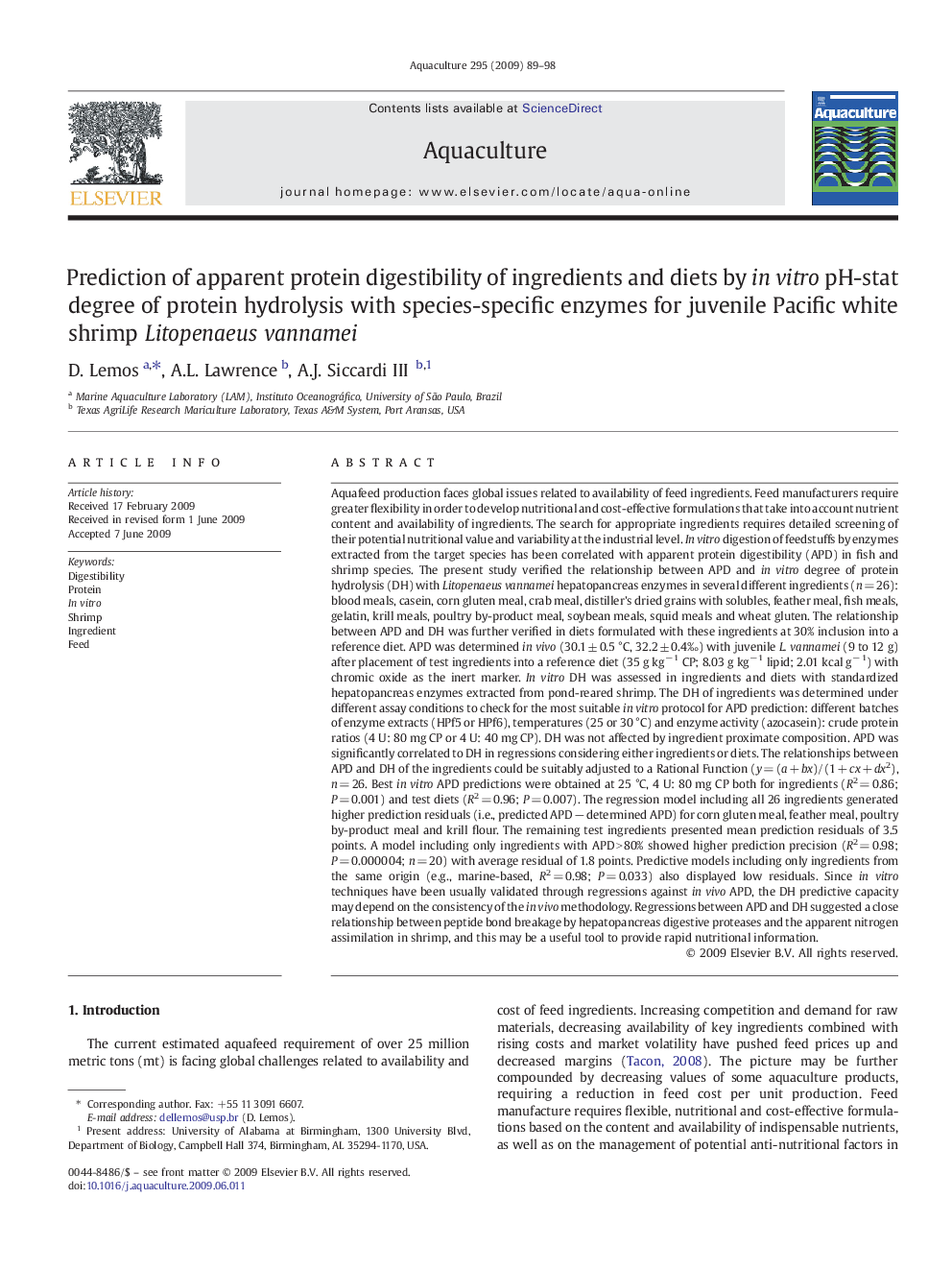| کد مقاله | کد نشریه | سال انتشار | مقاله انگلیسی | نسخه تمام متن |
|---|---|---|---|---|
| 2424079 | 1552937 | 2009 | 10 صفحه PDF | دانلود رایگان |

Aquafeed production faces global issues related to availability of feed ingredients. Feed manufacturers require greater flexibility in order to develop nutritional and cost-effective formulations that take into account nutrient content and availability of ingredients. The search for appropriate ingredients requires detailed screening of their potential nutritional value and variability at the industrial level. In vitro digestion of feedstuffs by enzymes extracted from the target species has been correlated with apparent protein digestibility (APD) in fish and shrimp species. The present study verified the relationship between APD and in vitro degree of protein hydrolysis (DH) with Litopenaeus vannamei hepatopancreas enzymes in several different ingredients (n = 26): blood meals, casein, corn gluten meal, crab meal, distiller's dried grains with solubles, feather meal, fish meals, gelatin, krill meals, poultry by-product meal, soybean meals, squid meals and wheat gluten. The relationship between APD and DH was further verified in diets formulated with these ingredients at 30% inclusion into a reference diet. APD was determined in vivo (30.1 ± 0.5 °C, 32.2 ± 0.4‰) with juvenile L. vannamei (9 to 12 g) after placement of test ingredients into a reference diet (35 g kg− 1 CP; 8.03 g kg− 1 lipid; 2.01 kcal g− 1) with chromic oxide as the inert marker. In vitro DH was assessed in ingredients and diets with standardized hepatopancreas enzymes extracted from pond-reared shrimp. The DH of ingredients was determined under different assay conditions to check for the most suitable in vitro protocol for APD prediction: different batches of enzyme extracts (HPf5 or HPf6), temperatures (25 or 30 °C) and enzyme activity (azocasein): crude protein ratios (4 U: 80 mg CP or 4 U: 40 mg CP). DH was not affected by ingredient proximate composition. APD was significantly correlated to DH in regressions considering either ingredients or diets. The relationships between APD and DH of the ingredients could be suitably adjusted to a Rational Function (y = (a + bx)/(1 + cx + dx2), n = 26. Best in vitro APD predictions were obtained at 25 °C, 4 U: 80 mg CP both for ingredients (R2 = 0.86; P = 0.001) and test diets (R2 = 0.96; P = 0.007). The regression model including all 26 ingredients generated higher prediction residuals (i.e., predicted APD − determined APD) for corn gluten meal, feather meal, poultry by-product meal and krill flour. The remaining test ingredients presented mean prediction residuals of 3.5 points. A model including only ingredients with APD > 80% showed higher prediction precision (R2 = 0.98; P = 0.000004; n = 20) with average residual of 1.8 points. Predictive models including only ingredients from the same origin (e.g., marine-based, R2 = 0.98; P = 0.033) also displayed low residuals. Since in vitro techniques have been usually validated through regressions against in vivo APD, the DH predictive capacity may depend on the consistency of the in vivo methodology. Regressions between APD and DH suggested a close relationship between peptide bond breakage by hepatopancreas digestive proteases and the apparent nitrogen assimilation in shrimp, and this may be a useful tool to provide rapid nutritional information.
Journal: Aquaculture - Volume 295, Issues 1–2, 1 October 2009, Pages 89–98